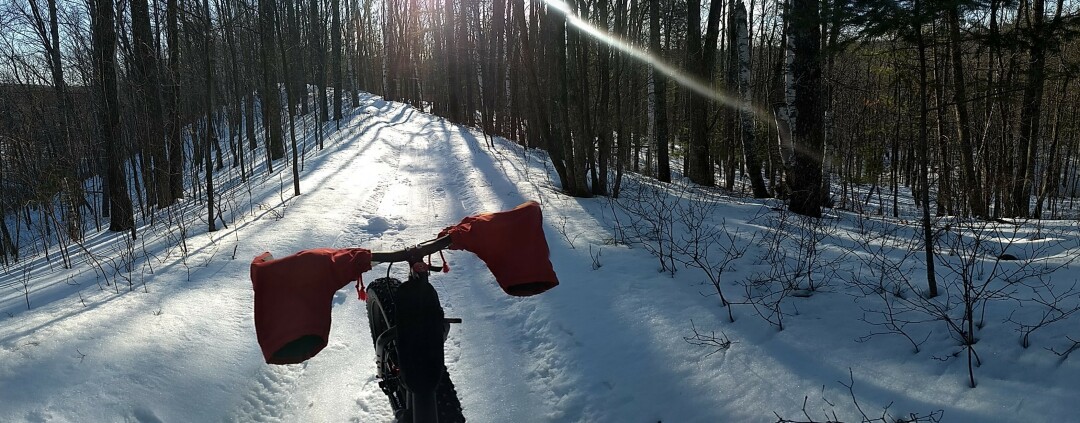Spring is just around the corner
And winter is, too!

The metal studs on my fat bike tires crunched noisily on the trail as I pedaled furiously toward the top of a hill. Reaching the crest, I sized up the view, crouched low over the seat, and zoomed down.
The air rushing past my face was chilly, but intense spring sunlight and tough pedaling on the slopes of the Esker Trail near Cable were keeping me plenty warm.
Several sunny afternoons in a row had softened the snow of the expertly groomed trail, and I had started my ride early to take advantage of overnight temperatures in the teens that had solidified the surface again.
Now, with firm, sidewalk-smooth path, gravity-fed momentum carried me almost all the way up the other side.
A few minutes later, I was reveling in the easy riding when I suddenly found myself tipped over with my left leg sunk up to the knee in drifts. This section of trail was contouring around the side of a steep hill. Winding switch-backs and curves had befuddled my sense of direction long ago, but I knew that the hill must be facing north.
On this corner, it was still winter. No glaring sun had hardened the surface, and I’d skidded out in soft fluff. My leg sank into snow that was as light and airy as January.
On the previous, sunny afternoon, the mercury had risen to almost 40 degrees, and I’d been cross-country skiing instead. The fish scales in my kick zone work rather well on warm snow, and I hummed along merrily for a kilometer or two.
Then, suddenly I found myself slipping and sliding up a relatively gentle hill. The slope wasn’t getting direct sun, but I could still see light glinting off a coating of ice in the tracks. Once again, even with my sense of direction lost in the winding trails, the iciness of the hill gave away its bearing.
In contrast, I had to squint against glare as I began the next downhill, and I almost fell over when a section of slush caught my skis.
A few days later, I went to bed with the sound of rain and thunder, and woke up to a world dusted in snow.
What I’m trying to illustrate, you may have guessed, is that this time of year is both winter and spring. Sometimes the two seasons are separated by a few feet, and sometimes the difference is in a few hours.
Outdoor enthusiasts pay close attention to this heterogeneity. Fat bikers wake early. Road bikers time their rides to hit the warmest peak of a sunny afternoon. Skiers brace themselves for sudden changes in speed.
Maple tree tappers carefully monitor temperature changes, too. They know that the sap flows best when nights are cold and days are warm; when an afternoon feels like spring, but winter returns with the dark.
Nature, of course, has no choice but to factor the fickleness of spring into her calculations. Trees who leaf out early in response to unseasonable warmth may then lose all of those leaves to frost, or may surrender entire branches if those leaves catch heavy, wet snow. They must hedge their bets and not be fooled.
According to Bernd Heinrich in his book Winter World, “Buds follow local schedules that are dictated by an interplay of cues involving day length, seasonal duration of cold exposure, and warmth. Warmth alone is not enough.”
And warmth can also vary quite dramatically from one side of a hill to the other. North-facing slopes receive very little heat from the low-angled winter sun. Even throughout the summer they remain shaded and cool, with less evaporation than their south-facing counterparts. Eastern aspects are similar, since they receive sun in the morning, when temperatures are lower. Western slopes, however, receive the full blast of the sun at the warmest time of day.
These variations in temperature by space and time are not a global phenomenon. Seasons are a characteristic of the temperate zone. The direction a hill faces only really matters in these same mid-latitudes. Near the equator, the sun is overhead and touches everything, all year. Near the poles, winter sun is too weak to provide much warmth and the summer sun circles around and shines on everything.
But in latitudes from the bottom of Mississippi to the top of Manitoba (and the corresponding latitudes in the southern hemisphere) slope aspect impacts sunshine, evaporation, soil moisture, and soil temperature…and the plants who grow there, too.
The variety we experience in the Northwoods – the way you can find an early wildflower in a sunny spot and a late one in the shade; the short scramble it takes to get from a dry oak slope to a damp hemlock ravine; the change from winter to spring and back in a single day or a single corner or a single hill – is one of the my favorite parts of living here.
At this time of year, it feels like spring is just around the corner…and winter is, too!
Emily Stone is Naturalist/Education Director at the Cable Natural History Museum. Her award-winning second book, Natural Connections: Dreaming of an Elfin Skimmer, is now available to purchase at cablemuseum.org/books. For more than 50 years, the Cable Natural History Museum has served to connect you to the Northwoods. The Museum is closed, but our Mysteries of the Night exhibit is available online. Connect with us at cablemuseum.org.
